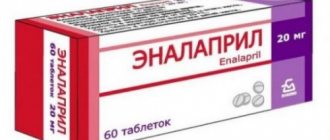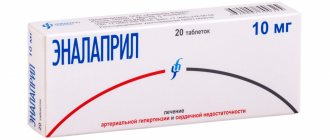Berlipril 10
Trade name: Berlipril 10 International name: Enalapril
Release form: tablets 10 mg (blisters)
Composition: enalapril maleate 10 mg
Pharmacological group: ACE inhibitor
Pharmacological group according to ATK: C09AA02 (Enalapril)
Pharmacological action: vasodilating, hypotensive, diuretic, potassium-sparing, ACE blocking,
Indications: Arterial hypertension (symptomatic, renovascular, including with scleroderma, etc.), stage I-III CHF, prevention of coronary ischemia in patients with LV dysfunction, asymptomatic LV dysfunction.
Dosage regimen: Orally, regardless of food intake. For monotherapy of arterial hypertension, the initial dose is 5 mg once a day. If there is no effect, after 1-2 weeks the dose is increased by 5 mg. After the initial dose, patients should be under medical supervision for 2 hours and an additional 1 hour until blood pressure stabilizes. If necessary and sufficiently well tolerated, the dose can be increased to 40 mg/day in 1-2 doses. After 2-3 weeks, switch to a maintenance dose - 10-40 mg/day, divided into 1-2 doses. For moderate hypertension, the average daily dose is about 10 mg. The maximum daily dose of the drug is 40 mg. If prescribed to patients concomitantly receiving diuretics, treatment with the diuretic should be discontinued 2-3 days before enalapril is prescribed. If this is not possible, then the initial dose of enalapril should be 2.5 mg/day. For patients with hyponatremia (serum Na+ concentration less than 130 mmol/l) or serum creatinine concentration more than 0.14 mmol/l, the initial dose is 2.5 mg 1 time per day. Renovascular hypertension: initial dose - 2.5-5 mg/day. The maximum daily dose is 20 mg. In severe cases of arterial hypertension, intravenous administration is possible (see Enalaprilat), carried out only in a hospital setting. For CHF, the initial dose is 2.5 mg once, then the dose is increased by 2.5-5 mg every 3-4 days in accordance with the clinical response to the maximum tolerated dose (depending on blood pressure), but not higher than 40 mg/day, once, or in 2 doses. In patients with low systolic blood pressure (less than 110 mm Hg), therapy should begin with a dose of 1.25 mg. Dose selection should be carried out over 2-4 weeks or shorter periods. The average maintenance dose is 5-20 mg/day in 1-2 doses. In the elderly, a more pronounced hypotensive effect and prolongation of the drug's action time are more often observed, which is associated with a decrease in the rate of elimination of enalapril, therefore the recommended initial dose for the elderly is 1.25 mg. For asymptomatic dysfunction of the LV function - 2.5 mg 2 times a day. The dose is selected taking into account tolerability up to 20 mg/day, divided into 2 doses. In chronic renal failure, cumulation occurs when filtration decreases to less than 10 ml/min. With CC 80-30 ml/min, the dose is usually 5-10 mg/day, CC 30-10 ml/min - 2.5-5 mg/day, less than 10 ml/min - 1.25-2.5 mg/day only on dialysis days. The duration of treatment depends on the effectiveness of the therapy. If the decrease in blood pressure is too pronounced, the dose of the drug is gradually reduced.
Contraindications: Hypersensitivity to enalapril or other ACE inhibitors, pregnancy, lactation.
Side effects: From the cardiovascular system: excessive decrease in blood pressure, orthostatic collapse, rarely - chest pain, angina pectoris, myocardial infarction (usually associated with a pronounced decrease in blood pressure), arrhythmias (atrial brady- or tachycardia, atrial fibrillation), palpitations, thromboembolism of the branches of the pulmonary artery . From the nervous system: dizziness, fainting, headache, weakness, insomnia, paresthesia, anxiety, depression, confusion, fatigue, drowsiness (2-3%), very rarely when used in high doses - nervousness, depression, paresthesia . From the senses: disorders of the vestibular apparatus, hearing and vision impairment, tinnitus. From the digestive system: dry mouth, loss of appetite, dyspeptic disorders (nausea, diarrhea or constipation, vomiting, abdominal pain), intestinal obstruction, pancreatitis, impaired liver function and bile secretion, hepatitis, jaundice. From the respiratory system: nonproductive “dry” cough, interstitial pneumonitis, bronchospasm, shortness of breath, rhinorrhea, pharyngitis. Allergic reactions: skin rash, angioedema of the face, limbs, lips, tongue, glottis and/or larynx, dysphonia, exfoliative dermatitis, exudative erythema multiforme (including Stevens-Johnson syndrome), toxic epidermal necrolysis (Lyell's syndrome) , pemphigus (pemphigus), pruritus, urticaria, photosensitivity, serositis, vasculitis, myositis, arthralgia, arthritis, stomatitis, glossitis. From laboratory parameters: hypercreatininemia, increased urea concentration, increased activity of “liver” transaminases, hyperbilirubinemia, hyperkalemia, hyponatremia, decreased Hb and hematocrit, increased ESR, thrombocytopenia, neutropenia, agranulocytosis (in patients with autoimmune diseases), eosinophilia. From the urinary system: impaired renal function, proteinuria. Other: alopecia, decreased libido, flushing of the face. Overdose. Symptoms: excessive decrease in blood pressure, up to the development of collapse, myocardial infarction, acute cerebrovascular accident or thromboembolic complications, convulsions, stupor. Treatment: the patient is transferred to a horizontal position with a low headboard. In mild cases, gastric lavage and ingestion of saline solution are indicated; in more serious cases, measures aimed at stabilizing blood pressure are indicated: intravenous administration of a 0.9% NaCl solution, plasma substitutes, if necessary, intravenous administration of angiotensin II, hemodialysis (enalaprilat elimination rate - 62 ml/min).
Pharmacodynamics: An ACE inhibitor is an antihypertensive drug, the mechanism of action is associated with a decrease in the formation of angiotensin II from angiotensin I, a decrease in the concentration of which leads to a direct decrease in aldosterone secretion. At the same time, peripheral resistance, systolic and diastolic blood pressure, post- and preload on the myocardium decrease. Dilates arteries to a greater extent than veins, while no reflex increase in heart rate is observed. Reduces bradykinin degradation, increases Pg synthesis. The hypotensive effect is more pronounced at high plasma renin concentrations than at normal or reduced levels. A decrease in blood pressure within therapeutic limits does not affect cerebral circulation; blood flow in the vessels of the brain is maintained at a sufficient level even against the background of reduced blood pressure. Strengthens coronary and renal blood flow. With long-term use, hypertrophy of the LV myocardium and myofibril of the walls of resistive arteries decreases, prevents the progression of CHF and slows down the development of LV dilatation. Improves blood supply to ischemic myocardium. Reduces platelet aggregation. Extends life expectancy in patients with CHF, slows down the progression of LV dysfunction in patients who have had myocardial infarction without clinical manifestations of HF. Has some diuretic effect. Reduces intraglomerular hypertension, slowing the development of glomerulosclerosis and the risk of chronic renal failure. Enalapril is a “prodrug”: as a result of its hydrolysis, enalaprilat is formed, which inhibits ACE. The onset of the hypotensive effect when taken orally is 1 hour, it reaches a maximum after 4-6 hours and lasts up to 24 hours. In some patients, therapy is required for several weeks to achieve an optimal blood pressure level. In CHF, a noticeable clinical effect is observed with long-term treatment - 6 months or more.
Pharmacokinetics: After oral administration, absorption is 60%. Eating does not affect absorption. It is metabolized in the liver to form the active metabolite enalaprilat, which is a more effective ACE inhibitor than enalapril. Plasma protein binding of enalaprilat is 50-60%. TCmax of enalapril - 1 hour, enalaprilat - 3-4 hours. Enalaprilat easily passes through histohematic barriers, excluding the BBB, a small amount penetrates the placenta and into breast milk. T1/2 of enalaprilat - 11 hours. Excreted mainly by the kidneys - 60% (20% - in the form of enalapril and 40% - in the form of enalaprilat), through the intestines - 33% (6% - in the form of enalapril and 27% - in the form of enalaprilat) . It is removed by hemodialysis (rate 62 ml/min) and peritoneal dialysis.
Special instructions: Caution must be exercised when prescribing to patients with reduced blood volume (as a result of diuretic therapy, limiting salt intake, hemodialysis, diarrhea and vomiting) - the risk of a sudden and pronounced decrease in blood pressure is increased after using even the initial dose of an ACE inhibitor. Transient hypotension is not a contraindication for continuing treatment with the drug after stabilization of blood pressure. In case of a repeated pronounced decrease in blood pressure, the dose should be reduced or the drug discontinued. If an excessive decrease in blood pressure develops, the patient is transferred to a horizontal position with a low head, and, if necessary, a 0.9% NaCl solution and plasma-substituting drugs are administered. The use of high-flow dialysis membranes increases the risk of developing an anaphylactic reaction. Correction of the dosage regimen on days free from dialysis should be carried out depending on the level of blood pressure. Before and during treatment with ACE inhibitors, it is necessary to monitor blood pressure, blood parameters (Hb, K+, creatinine, urea, liver enzyme activity), and protein in the urine. Patients with decompensated CHF, ischemic heart disease and cerebral vascular diseases, in whom a sharp decrease in blood pressure can lead to myocardial infarction, stroke or impaired renal function, should be carefully monitored. Sudden cessation of treatment does not lead to withdrawal syndrome (a sharp rise in blood pressure). Patients with a history of angioedema have an increased risk of developing it when taking ACE inhibitors. For newborns and infants who have been exposed in utero to ACE inhibitors, it is recommended to conduct careful monitoring for timely detection of a pronounced decrease in blood pressure, oliguria, hyperkalemia and neurological disorders that may be due to a decrease in renal and cerebral blood flow with a decrease in blood pressure caused by ACE inhibitors. With oliguria, it is necessary to maintain blood pressure and renal perfusion by administering appropriate fluids and vasoconstrictor drugs. In patients with reduced renal function, the single dose should be reduced or the intervals between doses should be increased. Before studying the functions of the parathyroid glands, enalapril should be discontinued. Caution should be exercised when performing physical exercise or in hot weather (risk of dehydration and excessive reduction in blood pressure due to a decrease in blood volume). Before surgery (including dentistry), the surgeon/anesthesiologist must be warned about the use of ACE inhibitors. During the treatment period, care must be taken when driving vehicles and engaging in other potentially hazardous activities that require increased concentration and speed of psychomotor reactions (dizziness is possible, especially after taking the initial dose of an ACE inhibitor in patients taking diuretic drugs). Carefully. History of angioedema during therapy with ACE inhibitors, hereditary or idiopathic angioedema, aortic stenosis, cerebrovascular diseases (including cerebrovascular insufficiency), coronary artery disease, coronary insufficiency, severe autoimmune systemic connective tissue diseases (including SLE , scleroderma), inhibition of bone marrow hematopoiesis, diabetes mellitus, hyperkalemia, bilateral renal artery stenosis, stenosis of the artery of a solitary kidney, condition after kidney transplantation, renal and/or liver failure, Na+-restricted diet, conditions accompanied by a decrease in blood volume (including . diarrhea, vomiting), elderly age, age under 18 years (safety and effectiveness of use have not been studied).
Interaction: Enhances the effect of ethanol, slows down the excretion of Li+. Weakens the effect of drugs containing theophylline. The hypotensive effect is reduced by NSAIDs and estrogens, and enhanced by diuretics, other antihypertensive drugs (beta-blockers, methyldopa, nitrates, BMCA, hydralazine, prazosin), drugs for general anesthesia, ethanol. Potassium-sparing diuretics and potassium-containing drugs increase the risk of developing hyperkalemia. Drugs that cause bone marrow suppression increase the risk of developing neutropenia and/or agranulocytosis. Immunosuppressants, allopurinol, cytostatics increase hematotoxicity.
Drug registration number: P No. 015007/01-2003
Date of registration (re-registration) of the drug: 06/30/2003
Instructions for use BERLIPRIL
Symptomatic hypotension
In uncomplicated arterial hypertension, hypotension is rare.
With a lack of fluid in the body, for example, due to diuretic therapy, a salt-depleted diet, dialysis, diarrhea or vomiting in patients suffering from arterial hypertension, symptomatic hypotension develops more often during treatment with Berlipril®. Symptomatic hypotension has been observed in patients with heart failure, with or without renal failure. This may particularly apply to patients with severe heart failure whose severity of the disease is reflected in high doses of loop diuretics, hyponatremia or limited renal function. Treatment of such patients - if a new dose of Berlipril® and/or a diuretic is to be selected - should be started under medical supervision, and this control should always be carefully continued in the future. The same applies to patients with coronary heart disease or cerebrovascular disease, in whom an excessive drop in blood pressure can lead to myocardial infarction or cerebral stroke.
If hypotension develops, the patient should be placed in a horizontal position and, if necessary, given an intravenous infusion of sodium chloride solution. A transient hypotonic reaction is not a contraindication for further treatment, which can usually be carried out without problems after normalization (by replenishing the circulating blood volume) of blood pressure.
In some patients with heart failure whose blood pressure is normal or low, Berlipril may further reduce systemic blood pressure. This far from unexpected effect is usually not a reason to discontinue the drug. If the decrease in blood pressure becomes symptomatic, i.e. will be accompanied by symptoms, it may be necessary to reduce the dose of Berlipril® and/or diuretic and/or discontinue Berlipril®.
Aortic or mitral stenosis/hypertrophic cardiomyopathy
As with other vasodilators, special caution is recommended when using ACEIs in patients who have left ventricular valve obstruction and outflow tract obstructions. In case of shock accompanied by circulatory failure and a hemodynamically obvious obstruction in the outflow tract, the use of these drugs should be avoided.
Renal dysfunction
In patients with limited renal function (creatinine clearance <80 ml/min), the initial dose of enalapril maleate should be adjusted depending on the patient's creatinine clearance. The maintenance dose is selected depending on the patient's response to treatment. In these patients, monitoring of serum potassium and creatinine is routine as part of their usual medical management.
In particular, renal failure has been reported in association with the use of enalapril maleate in patients with severe heart failure or underlying renal disease, including renal artery stenosis. With timely diagnosis and appropriate treatment, renal failure during therapy with enalapril maleate is usually reversible.
In some hypertensive patients who do not have kidney disease, the combination of enalapril maleate with a diuretic may result in an increase in serum urea and creatinine levels. In such cases, it may be necessary to reduce the dose of enalapril maleate and/or discontinue the diuretic. In this case, one must think about possible stenosis of the renal arteries as the cause of these phenomena.
Renovascular hypertension
In patients with bilateral renal artery stenosis or renal artery stenosis of a single functioning kidney, treatment with ACE inhibitors poses a particular risk of a drop in blood pressure or the development of kidney failure. Loss of renal function may occur, often resulting in only mild changes in serum creatinine. Treatment of these patients should be started with low doses and under strict medical supervision, carefully titrating the dose and monitoring renal function.
Kidney transplantation
There is no experience with the use of Berlipril® in patients who have recently undergone kidney transplantation. Therefore, treatment of such patients with this drug is not recommended.
Liver failure
During treatment with ACE inhibitors, a syndrome has occasionally been observed, starting with cholestatic jaundice and progressing to fulminant hepatic necrosis (sometimes fatal). The pathogenesis of this syndrome is unclear. In the case of patients who develop jaundice or a clear increase in liver enzyme levels during treatment with ACEIs, discontinuation of the ACEI and appropriate treatment are necessary.
Neutropenia/agranulocytosis
Neutropenia/agranulocytosis, thrombocytopenia and anemia have been reported in patients receiving ACE inhibitors. In patients with normal renal function and without special risk factors, neutropenia rarely occurs. In patients suffering from collagenosis with vascular involvement, as well as those being treated with immunosuppressants, allopurinol, procainamide, or in patients with several of these risk factors, enalapril maleate should be used with extreme caution, especially if there is limited renal function. Some of these patients developed severe infections that in some cases did not respond to intensive antibiotic therapy. If these patients are taking enalapril maleate, they are advised to have their white blood cell count regularly monitored and are encouraged to report any signs of any infection to their doctor.
Hypersensitivity/angioedema
Angioedema involving the face, extremities, lips, tongue, vocal folds and/or larynx has been reported in patients treated with ACE inhibitors, including Berlipril®. They may appear at any time during treatment. In these cases, Berlipril® should be discontinued immediately. To ensure complete reversal of symptoms before discharge from the hospital, the patient must be closely monitored. In cases where swelling of the face and lips was limited, symptoms in most cases reversed without treatment. However, antihistamines were beneficial in reducing symptoms.
Angioedema involving the larynx can be fatal. If the tongue, vocal folds or larynx are involved and there is a risk of airway obstruction, appropriate treatment should be started immediately (for example, subcutaneous injection of 0.3-0.5 ml of epinephrine [dilution 1:
- 1.000]) and/or take measures to ensure airway patency.
A higher incidence of angioedema has been reported with ACEI therapy in black patients compared with non-black patients.
Patients with a history of angioedema not caused by ACEIs may have an increased risk of developing it when taking ACEIs.
Anaphylactoid reactions during desensitization therapy directed against insect venoms
Rarely, life-threatening anaphylactic reactions have been observed during desensitization therapy directed against insect venom and simultaneous use of ACE inhibitors. If specific immunotherapy (desensitization) directed against insect venom is indicated, then ACE inhibitors must be temporarily replaced with other drugs for the treatment of arterial hypertension or heart failure.
Anaphylactoid reactions during LDL apheresis (low-density lipoprotein plasmapheresis)
During LDL apheresis with dextran sulfate, life-threatening anaphylactoid reactions have occurred rarely during concomitant use of ACE inhibitors. If LDL apheresis is indicated, then ACE inhibitors should be temporarily replaced with other drugs for the treatment of arterial hypertension or heart failure.
Patients undergoing hemodialysis treatment
Anaphylactoid reactions have been reported when using high-flux membranes (eg, "AN 69") during dialysis and concomitant use of ACE inhibitors. Therefore, in such patients it is necessary to use either a different membrane or an antihypertensive agent of a different class of substances.
Patients suffering from diabetes mellitus
In patients with diabetes mellitus who are being treated with oral hypoglycemic drugs or insulin, blood sugar levels should be carefully monitored during the first month of treatment with ACE inhibitors.
Cough
Cough has been reported in association with the use of ACEIs. The absence of sputum is typical, the cough is persistent and disappears after discontinuation of treatment. Cough caused by ACEI therapy should also be considered in the differential diagnosis of cough.
Surgery/anesthesia
In patients undergoing major surgery or anesthesia with drugs that lower blood pressure, enalapril maleate inhibits, in response to compensatory secretion of renin, the production of angiotensin II. If hypotension develops on this basis, it can be corrected by replenishing the volume of circulating blood.
Hyperkalemia
Increases in serum potassium concentrations have been observed in some patients treated with ACE inhibitors, including enalapril maleate. Risk factors for developing hyperkalemia are:
- renal failure, diabetes mellitus, simultaneous treatment with potassium-sparing diuretics, taking potassium supplements or potassium-containing salt substitutes, as well as simultaneous treatment with other drugs that can lead to an increase in serum potassium levels (eg, heparin). If the simultaneous use of the above substances is indicated, then regular monitoring of serum potassium levels is recommended.
Lithium
In general, lithium preparations are not recommended to be combined with enalapril maleate.
Use in pediatric patients
Regarding the use of Berlipril® in children over 6 years of age with arterial hypertension, data regarding efficacy and tolerability are limited. There is no information regarding other indications. There is limited information on pharmacokinetics for children older than 2 months. Berlipril® is recommended for children only with arterial hypertension.
Enalapril maleate is not recommended for newborns and pediatric patients whose glomerular filtration rate is <30 ml/min/1.73 m2, since there is no information about this.
Pregnancy and lactation
Enalapril maleate should not be used during pregnancy. If long-term therapy with enalapril maleate is necessary, patients planning pregnancy should switch to alternative treatment with antihypertensive drugs that have a proven safety profile during pregnancy.
If pregnancy is diagnosed, then enalapril maleate should be stopped immediately and, if necessary, treatment with alternative agents should be started.
Berlipril® is contraindicated in the 2nd and 3rd trimesters of pregnancy. Berlipril® is not recommended for use during lactation.
Ethnic differences
The severity of the hypotensive effect of enalapril maleate - as in the case of other ACEIs - in black patients, obviously, may be less than in non-black patients; this is presumably due to the fact that black patients with hypertension often have reduced plasma renin levels.
Other
This medicine contains lactose. Patients suffering from rare hereditary galactose intolerance, lactase deficiency or glucose-galactose malabsorption syndrome should not take this drug.
Impact on the ability to drive vehicles and maintain machines
When actively participating in street traffic or servicing machines, be aware that dizziness or weakness may occur.




